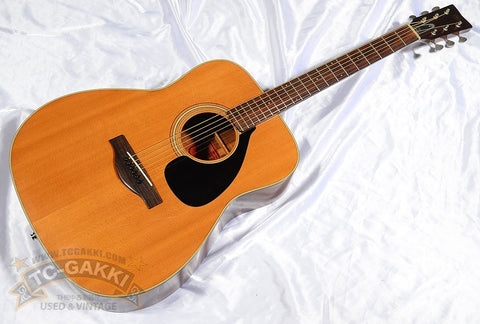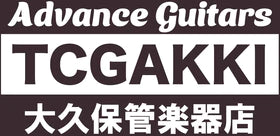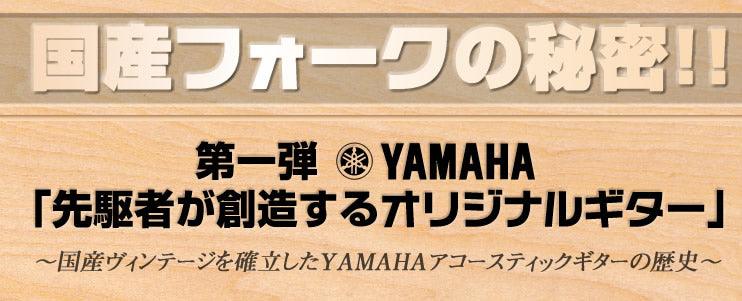
[Origins in motion in 1965
In 1965, YAMAHA, which had been manufacturing and selling the "Dynamic Guitar," an original guitar with a classical guitar body shape but steel string specifications, began full-scale development of the folk guitar.
It is said that the company began developing guitars for export in response to the American market's demand for reasonably priced guitars.
At the time, electric guitars were at the height of the Japanese music scene, as represented by the Ventures. The term "100 million electric guitars" was even coined.
In contrast, the modern folk movement had begun in the U.S., and Japanese-made guitars for beginners in both electric and folk music were selling like hotcakes.



Two FG models appeared.
The following year, in October 1966, the first Japanese-made folk guitars of original design, the FG-150 and FG-180, finally went on sale.
Production of the first domestically produced FG series began with the idea of polarizing sizes from the outset. These were the "FG-150," which was a bit smaller with a folk body, and the "FG-180," which had a western body.
Other than size, the specifications were the same: spruce veneer top, 3-piece mahogany plywood sides, and mahogany veneer back.
However, within a few months of its sale, the specifications were changed to plywood for both the top and back.
The distinctive feature is the scale. While normal acoustic guitars are around 650mm, YAMAHA adopted 634mm.
This indicates that the guitar was designed to fit the Japanese physique. Bracing is X bracing. The label is "light green label.
The regular price of "FG-150" is 15,000 yen, and that of "FG-180" is 18,000 yen, which may seem like a bargain, but since it was made in the 1960s, it is equivalent to one month's salary for an adult.
Even if it is said that it was made cheaply, it is still a gem from an era when guitars were still a luxury item.


The era is catching up with us.
In 1967, a full-fledged folk movement finally arrived in Japan.
An unprecedented folk boom began with the big hit "Kitaitekita Yopparai" by the Folk Crusaders.
Perhaps sensitive to the times or the timing, Yamaha launched the FG-110, a low-priced version of the FG-150, and the FG-230, a 12-string version, in April.
In 1968, minor changes were made to keep up with the times. From this year, the "green label" was discontinued and the "red label" was introduced, and YAMAHA guitars quickly penetrated the market.
In 1969, YAMAHA discontinued the production of solid guitars in contrast to FG, which had completely taken off.
In March, the "FG-140," a low-priced version of the FG-180, was released.
Incidentally, the "FG-500" is known as a rare model that is particularly difficult to obtain even now because the initial rods were made of Hakaranda side and back.




The designer who changed the times.
In 1970, YAMAHA was so busy producing and marketing the FG that it was impossible to make minor changes to existing products, let alone plan a new model.
In 1971, YAMAHA, aiming to expand its business, invited a designer to work for the company in order to achieve world-class standards. Mr. Terumi Nakamoto, a.k.a. Terry Nakamoto, was a guitar designer of rare fame.
The project led by Terry Nakamoto produced the FG-1500, FG-2000, and FG-2500, a lineup of fully handmade, high-end guitars.
The music scene seemed to react to this vision of YAMAHA's future. Surprisingly, Bob Dylan, one of the leading figures of the scene, used the FG-1500!
This was the beginning of the YAMAHA acoustic guitar's rise to the top of the world in no time!




[From the demise of the red label to the introduction of a new color label
The "red label" design, with its widened head tip, was replaced by the "green label" in 1972.
The design of the head changed from the "Green Label" model and became tapered.
Minor changes were made to the "Black Label" in 1974 and the "Beige Label" in 1980.
In the "green label" era, a distinctive model was introduced for the first time.
These were the "FG-350E," a model with built-in pickups, and the "FG-600S," equipped with an adjustable bridge and featuring a sunburst finish.
In addition, in line with the still booming economic background, many mid-priced models such as the "FG-580," "FG-630," "FG-700," "FG-850," and "FG-1000" were also introduced to augment the vertical lineup.
During the black-label era, which began in 1974, the lineup totaled 25 models.
It could be said that this was the most fulfilling period, with a good balance between demand from the music scene and sharing from YAMAHA.








The birth of the new L Series.
In December 1974, a new tradition began with the release of the "L-31," the L Series. The L series could not be called reasonable, with the lowest-priced model having a list price of 50,000 yen.
The jumbo body was adopted in order to launch itself into the world as a rider in the new era of YAMAHA. It gained a certain reputation among players who were aware of the overseas music scene, and also led to a reevaluation of the FG's suitability for the Japanese body shape.
The following year, 1975, saw the appearance of a custom model acoustic guitar that would later be known as the "L Four Heavenly Kings.
The four guitars were the L-51 Custom, with its eye-catching asymmetrical design; the L-52 Custom, with its J-200-type jumbo body; the L-53 Custom, with its distinctive inlays from the head to the fingerboard; and the L-54 Custom, with its maple body full of DOVE taste.
The leather labels are, of course, personally inspected and signed by this man. Yes, it is by Terry Nakamoto.
Also in 1974, the L series was introduced with the L-5, L-6, L-7S, L-8, L-10, L-12S, L-12SN, and L-15, which are popular as standard models and in the used market today. In addition, the "L-12-5" and "L-12-8," which are 12-string models, will also be dropped on the market.








FG series and L series in the pre-modern period
The FG series underwent a full model change in March 1986, with a change to an "ivory label. The FG series underwent a full model change in March 1986 with an "ivory label" and a "pigeon" design on the head, and entered the era known as the "Pigeon FG".
As electric bands became the main trend in music, the FG series changed its role to that of an entry-level model in comparison with the L series.
The L series, on the other hand, was loved and appreciated for a long time until the LL series was introduced in November 1985, and reigned as the standard model of YAMAHA.


The Future of YAMAHA Acoustic Guitars
In the 1990s, old FGs began to become the talk of the town, and in October 1995, limited reissues of the FG-180 and FG-150 were released to celebrate the 30th anniversary of the FG series.
Although it is nothing new now, this was the first time that a Japanese brand reissued its own acoustic guitars.
In November 2000, YAMAHA released the FG-B1N and FGX-B1N, the world's first guitars to use "bamboo" for the body material.
Bamboo had previously been considered impossible to process into guitars, but YAMAHA took on the challenge and successfully accomplished it, both because of its environmental friendliness and because of its high supply as a resource.
As a side note, YAMAHA later went on to manufacture drums using bamboo.
In March 2002, YAMAHA launched "The FG" and developed "The FS" at the same time. After a short delay, Yamaha reissued the L-51 Custom in 2010. In 2012, "L-53 Custom" was reissued.
By simultaneously developing acoustic guitars that match the current era and revisiting the good old acoustic guitars, Yamaha may be seeking a path to the coming 2020s.
Even though the handling of wood itself has been the focus of much attention in recent years, acoustic guitars will always be found in the hands of those who enjoy music.
Some people pick up a vintage YAMAHA and play songs with memories of those days, while others pick up a brand-new YAMAHA and press their first chords.
It has already been more than 50 years since the first FG was introduced. No matter which vintage YAMAHA acoustic guitar you pick up, you will find the history, technology, and passion that YAMAHA has cultivated in it.











